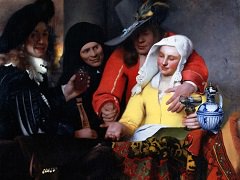Woman with a Lute, 1662 by Johannes Vermeer

A young woman wearing an ermine-trimmed jacket and a large pearl earring looks eagerly out the window while tuning a lute. The viola da gamba on the floor and songbooks on the table anticipate
company. The figure is set within counterpoised rectangles, but Vermeer's subtle light and shadows draw a veil over the calculated design. The picture is abraded, especially in the foreground,
where the paint has also darkened with age.
Vermeer, from the beginning of his career as a genre painter, tended to establish a barrier between his figures and the viewer. This compositional device served two purposes: it reinforced the
sense of privacy with which he endowed his figures, and it created a feeling of depth in his paintings. In only a few instances, however, is this foreground element as dramatic as it is in the
Woman with a Lute. Because in this painting the woman is seated and the point of view is low, the contrast between her scale and that of the lion finial chair and cloth in the foreground
is emphasized. This contrast gives a greater threedimensional impact to the painting than is evident in Vermeer's other portrayals of single figures.




















